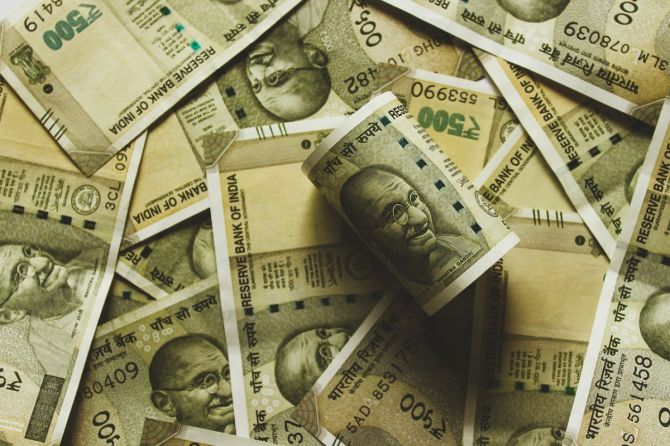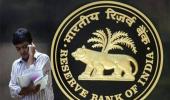Market participants attribute the stability to the RBI's timely intervention in the foreign exchange market, both in terms of selling and buying dollars.

The rupee displayed remarkable stability against the US dollar in 2023, marking the least volatility witnessed in nearly three decades.
The local currency experienced a marginal depreciation of 0.5 per cent against the greenback.
The last time the Indian unit exhibited such stability was in 1994, when it appreciated by 0.4 per cent.
Market participants attribute the stability to the Reserve Bank of India's timely intervention in the foreign exchange market, both in terms of selling and buying dollars.
Moreover, the domestic market witnessed robust foreign inflows, which kept the rupee afloat during global uncertainties.
The RBI remained active in the market throughout the year to curb the volatility in the exchange rate.
Market participants said that the timely intervention protected the local currency from weakening further to 84 per US dollar this year.
Market participants believe that the rupee might regain its ground in 2024 against the greenback on the back of foreign inflows.
The local currency might appreciate up to Rs 82 per dollar during the year.
While most of the emerging market currencies regained their ground against the US dollar in November, the Indian rupee lagged its peers, primarily due to persistent demand for the dollar among importers.
On November 10, it had hit a record of 83.48 against the dollar.
The expected inflows resulting from India's inclusion in the JP Morgan bond index are seen starting from January.
While the central bank is poised to absorb a significant portion of these inflows, the overall impact is anticipated to be beneficial for the country's balance of payments, leading to a surplus, market participants said.
"The reason behind the stability is the RBI's intervention. And the other factor is that our current account deficit has remained less than 2 per cent in FY24," said Gaura Sengupta, economist at IDFC First Bank.
"We expect it to strengthen in the next year, and trade between Rs 82 and Rs 80 per dollar," she added, "as we expect the flows to come in because of India's inclusion in the JP Morgan bond index. The interest rate differential is expected to widen. The RBI rate cut cycle is expected to follow the Fed with a delay, and is expected to be shallower."
JP Morgan had announced the inclusion of India in its widely followed emerging market bond index on September 22.
India will be included in its flagship index GBI-EM Global Diversified index, a process that will start from June.
The inclusion will be phased over a 10-month period, with 1 per cent weight included in each month till March 31, 2025.
Indian bonds will have 10 per cent weight, like China.
A total of $25 billion to $30 billion inflows are expected due to the bond index inclusion, market participants said.
Meanwhile, the US Federal Reserve hinted at three potential interest rate cuts in 2024 at the last meeting.
Back home, the monetary policy review on the whole was interpreted by the market as dovish as compared to the previous two policies.
The domestic rate-setting panel decided to keep the policy repo rate unchanged at 6.5 per cent for the fifth straight review meeting and the withdrawal-of-accommodation stance while stopping short of clearly communicating that the rate cycle had peaked.
The market expects that the current quarter may mark the bottom of the economic cycle.
From the next quarter onwards, there is an optimistic forecast for an uptick in economic activities.
Another reason for this optimistic outlook is the expected actions of central banks.
The Reserve Bank is expected to initiate rate cuts, following a three-month lag after the projected rate cut from the Federal Reserve in May.
"The rupee remains underpinned by the retreat in US treasury yields and falling oil prices. The resumption of FPI inflows in Indian capital markets can also help the sentiment," said Hitesh Jain, strategist, Institutional Equities Research, at Yes Securities India Ltd.
"The RBI governor," he added, "has said that the Indian rupee has witnessed low volatility and orderly movements when compared with other emerging market currencies."
Marginal decline in the Indian rupee on a YTD basis validates the RBI's standpoint, he said.
"India's CAD/GDP for FY24 is seen at 1.7 per cent, which is much better than the FY23 number. On economic growth, FY24 GDP growth is upwardly revised to 7 per cent, quite an enviable number when compared with the global backdrop."
The Indian unit was stable in the first half of 2023 after a turbulent 2022 following the war in Europe and interest rates hike by the US Federal Reserve.
It appreciated by 0.16 per cent in the first six months of the current calendar year on the back of robust foreign inflows.
"The rupee has outperformed other emerging market currencies primarily because the RBI has kept it in a tight band," the treasury head at a private bank said.
"And obviously in the last few months we have seen a reversal of fortune in terms of FPI inflows. In July and August, equity markets saw some stream in terms of FPI. We have seen a curve come back in November and a little October as well. I think that has assisted the currency."
The weakening of the yuan was the primary reason for the weakening of the rupee in August, prompted by the reduction of the interest rate differential between the yuan and the US dollar.
Geo-political tensions in West Asia and rising crude oil prices led to foreign outflows, which further weighed on the local currency starting October.
The dollar index, which measures the strength of the greenback against a basket of six major currencies, rose up to 107 on the safe-haven demand due to geopolitical tensions.
In the current financial year, the rupee has depreciated by 1.2 per cent, whereas in the current calendar year, it has depreciated by 0.5 per cent so far.

Feature Presentation: Aslam Hunani/Rediff.com











